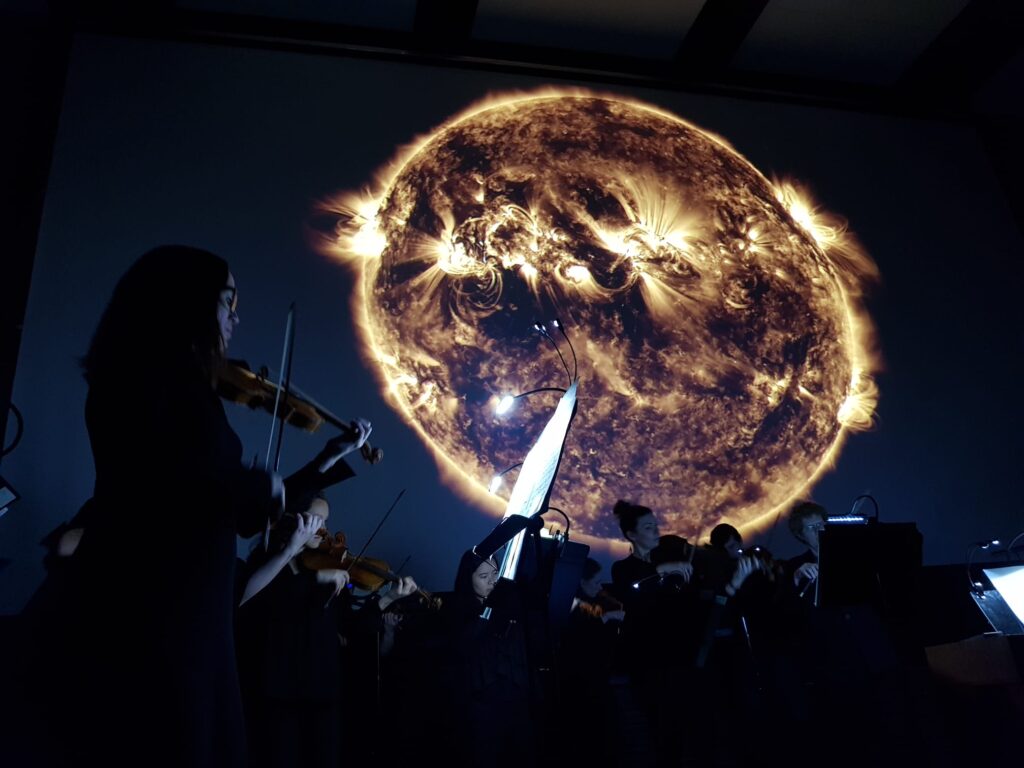Grab your popcorn and pull up a beanbag for Australian Baroque’s audiovisual tour of terrestrial and extra-terrestrial wonders, recommends Claire Coleman.
Music to move the planets
9 August 2021
- Reading time • 5 minutesMusic
More like this
- Rewriting tradition with skill and charm
- Close encounter stirs the soul
- The great unknown
Space Music, Australian Baroque ·
Girls School, 7 August 2021 ·
It’s not often that a chamber work is performed to the aroma of popcorn and toasted sandwiches, but olfactory and gastronomical delights were available alongside the promised optical and auditory treats at Australian Baroque’s Space Music.
Conceived by Australian Baroque Artistic Director Helen Kruger in conjunction with her partner, planetary geologist Dr Antony Brian, and early music specialist Stewart Smith, Space Music is a modern interpretation of “the harmony of the spheres”. This late Renaissance/early Baroque concept comes from scholars linking music and science in their attempts to understand the universe, using mathematical formula to plot both the movement of the planets and the consonance of the musical scale.
Brian narrates the secrets of the skies, and humanity’s curiosity about them, in six micro-lectures on a particular aspect of the cosmos. Music from Kruger and the ensemble, which for some pieces includes period woodwinds and percussion alongside strings and harpsichord, is interspersed between the narrations, and performed to a backdrop of satellite and telescope images of stars, planets and galaxies.

We begin where we all began, with the Big Bang. The chaos of creation is captured in whirling images of stars and gas clouds, alongside excerpts from Jean-Féry Rebel’s Les Élémens in a dissonant and frenetic opening.
One of the many kids in the audience beats Brian to the segue, exclaiming “It’s the sun!” when the new image appears on-screen. Brian elaborates with a mind-boggling array of figures describing the sun’s composition and fuel burning capacity. Thomas Arne’s “The glitt’ring sun” follows, soprano Emma Oorschot dazzling with her bell-like and brilliant tone, and then Handel’s Concerto Grosso Op. 6 No. 5 evokes the energy of a solar flare.
The focus of proceedings shifts to the planets of our solar system. First “The Rocky Planets”, a term encompassing Mercury, Mars, Venus and our own Earth, featured alongside Corelli’s Concerto Grosso Op 6 No 8 and Biber’s Battalia. Next our attention turns to “The Giant Planets”. The slow and stately movements of Jupiter, Saturn, Neptune and Uranus come across in the Grave and Largo of Concerti Armonici No. 3 by Unico Willhelm van Wassenaer.
While the absence of any real explanation about the curatorial decisions governing the combinations of image, music and narration was a bit of a missed opportunity, the exploration of “Deep Space” showed how well this can work when in alignment. Beata Viscera (Blessed Offering), a sacred chant by enigmatic French composer Pérotin, already stood out as the only medieval piece in an otherwise Baroque program. The intensity of this difference was magnified by its compelling pairing with elemental images of distant stars and galaxies.
In an arrangement by Smith, who also conducts this piece, drones enter and exit different sections of the ensemble to fuel a slow harmonic burn, in symbiosis with the melismatic Latin chant sung by Oorschot. The restless audience falls still in contemplation of the human and the eternal, the expansive vastness of whirling galaxies set against the ancient reverie of terrestrial song.
To conclude, we orbit closer to home and consider the Moon. The lively closing Chaconne by Rameau is the work largest in scale on the program, with sweet and resonant oboes and bassoon adding richness and depth to the ensemble.
Brian’s closing narration proves a fitting end. He recounts stories of astronauts visiting the Moon, bursting with curiosity about its landscape and atmosphere, only to arrive and find themselves overcome by the beauty of their own far away little blue planet turning softly around the Sun.
Space Music was an opportunity to marvel, both at wonders made at home and those in the dizzying expanse we occupy.
Australian Baroque’s next concert series is “Bach and Beer”, 14 – 19 October 2021.
Pictured top: Australian Baroque musicians perform “Space Music”. Photo supplied
Like what you're reading? Support Seesaw.






